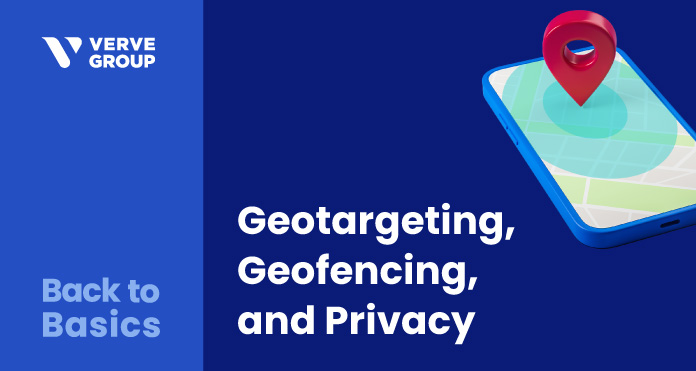Bullseye! That’s the magical moment marketers dream of when their message reaches the right person, at the right moment, and in the right place. With so many factors at play, how do marketers figure out the “right place” piece of the puzzle? Buckle up: we’re getting #BackToBasics by defining geotargeting vs. geofencing, benefits for marketers and DSPs, as well as important privacy compliance considerations.
How does geotargeting work?
Geotargeting is a method of using physical location, rather than personal identifiers, to reach audiences. This allows advertisers to deliver location-relevant messaging to consumers without relying on personal data like cookies or mobile device IDs.
How does geofencing work?
Geofencing is a radius-driven form of geotargeting. For geofencing, advertisers and DSPs define a radius based on an exact point defined by latitude and longitude. Rather than simply targeting by city, state, or ZIP code, marketers choose geofencing to reach people near a point of interest. This is especially helpful for advertisers and DSPs targeting areas near entertainment venues, sports arenas, shopping centers, restaurants, and school campuses. Geofencing can be especially effective when timed correctly. For example, a food delivery service might boost its media spend around a college during finals week, sharing promo codes and sympathetic messaging about surviving exams.
Geotargeting vs. Geofencing, Regional Targeting, Geo Targeting, or Geotargeted Ads: Is there any difference?
What’s in a name? Not much when it comes to geotargeting. You might find it referred to as regional targeting, geotargeted advertising, geo targeting, or something along those lines. Some marketers also use the term “proximity targeting” instead of geofencing. (We’re going to stick with geotargeting and geofencing, though.)
Geotargeting and privacy implications
Changing data privacy regulations, shifting consumer expectations, measurement/attribution challenges, and surprising tech updates mean marketers and DSPs need identifier-free options to target audiences. As privacy-compliant, first-party data becomes harder to come by, geotargeting and geofencing are essential tools to target campaigns accurately and effectively. Simply put, you can literally reach people where they are, without having to know who they are.
“Cookieless is the term everyone uses, but really everything is starting to fade into more of an ‘ID-less’ approach. Yes, there are third-party cookie limitations, but we also face the same challenges in other environments, such as in-app, where mobile advertising IDs, and IP addresses. Other personal identifiers are increasingly opt-in-only or limited, as well. As a result, geotargeting offers a privacy-compliant way to reach relevant users/viewers/people without relying on IDs, and without compromising user privacy.”
Sebastian Höft | Product Manager at Verve
Geotargeting Benefits for DSPs and advertisers
Focusing on geographically-relevant areas can mean a more efficient use of marketers’ media budgets, reducing wasted spend and boosting ROAS. According to Alysa Rowlands, Senior Product Manager, “Geotargeting is a great way to ensure efficiency in your line items by focusing impressions in the right locations.”
Macro and micro levels of geotargeting
Marketers can think big – or small – with their geotargeting selections. For example, macro-level geotargeting might mean including (or excluding!) certain regions, continents, or countries.
On the other end of the spectrum, marketers can use micro-level geotargeting to get local, connecting with audiences via area-specific campaigns. For example, advertisers might run a campaign focused on a local festival, using geotargeting to spread relevant, fun content to the community. To achieve this granularity and hyper-relevant content, marketers can target by ZIP codes, setting a geofence, or selecting DMAs.
By using location, not identity, to reach the right audiences, geotargeting presents DSPs and marketers with a targeting option that’s truly privacy-compliant, all without the complications of identifiers.
Geotargeting is a big win for consumers, too. Brands can provide content that’s more relevant, resulting in a better user experience and higher engagement. Over time, these kinds of improved experiences can contribute to a more positive brand sentiment.
There you have it: that’s the #BackToBasics gist of geotargeting! Curious about identifiers, privacy, and contextual-based targeting? We’ve got you covered:
-
- Identity: Decoded
- Get ID’d: On the Road to the New Privacy-Focused Normal
- Contextual Audience Segments
About Back to Basics: Advertising technology is a complicated world. What’s more, it’s constantly changing. That’s why it’s so important to develop a strong understanding of the nuts and bolts of ad tech. The Back to Basics blog series is dedicated to providing readers accurate, simple, and useful information about ad tech. Whether it’s untangling jargon, breaking down the advertising supply chain, or figuring out what trends actually matter to you, Verve’s team is here to help you make sense of it.








